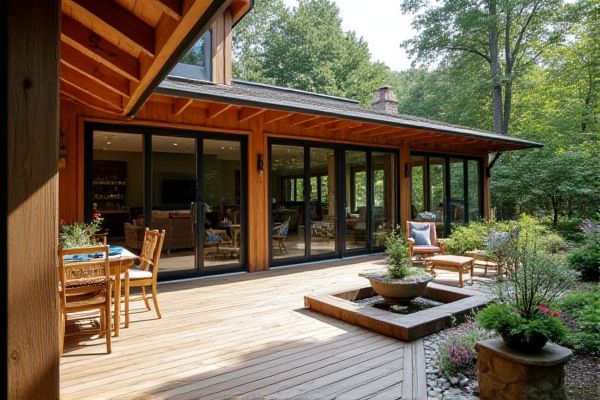
A deck is typically a raised wooden platform attached to a house, providing an elevated outdoor living space, while a patio is a ground-level area made of concrete, stone, or pavers, designed for entertaining or relaxation. Explore the rest of the article to discover which option best suits Your outdoor lifestyle and home design.
Table of Comparison
| Feature | Deck | Patio |
|---|---|---|
| Material | Wood, composite, or PVC | Concrete, stone, brick, or pavers |
| Elevation | Elevated structure above ground | Ground-level surface |
| Installation | Framed and built | Poured or laid on existing ground |
| Maintenance | Medium to high (sealing, sanding) | Low (cleaning, occasional sealing) |
| Cost | Moderate to high | Low to moderate |
| Lifespan | 10-30 years (with maintenance) | 20-50 years |
| Design Flexibility | Custom shapes, multi-level options | Varied patterns, permanent layout |
| Climate Suitability | Better in dry climates | Ideal for humid or wet areas |
| Resale Value | Higher perceived value | Moderate perceived value |
Introduction to Decks and Patios
Decks and patios are popular outdoor living spaces that enhance your home's functionality and aesthetic appeal. Decks are typically raised structures made from wood or composite materials, offering elevated views and versatility in design. Patios are ground-level surfaces constructed from concrete, stone, or pavers, providing a sturdy, durable area ideal for dining and relaxation.
Key Differences Between Decks and Patios
Decks are elevated wooden structures typically built above ground level, offering a versatile outdoor space that can accommodate seating, dining, and entertainment. Patios, usually constructed from concrete, stone, or brick, are ground-level surfaces that provide a durable and low-maintenance area for outdoor activities. Understanding these key differences helps you decide the best option for your outdoor living needs based on style, budget, and site conditions.
Material Options: Decks vs Patios
Decks offer a variety of material options such as pressure-treated wood, cedar, redwood, and composite materials that provide durability and aesthetic appeal. Patios are typically constructed from concrete, stone, brick, or pavers, allowing for versatile design patterns and lower maintenance. Choosing between decks and patios depends on preferred materials, cost, climate suitability, and desired landscaping integration.
Cost Comparison: Deck vs Patio
A deck typically costs between $15 and $35 per square foot depending on materials like pressure-treated wood or composite, while patios generally range from $8 to $20 per square foot with options such as concrete or stone. Maintenance expenses for decks can be higher due to sealing and wood care, whereas patios often require less frequent upkeep. Your budget and desired durability should guide whether a deck or patio offers better long-term value for outdoor living space.
Maintenance Requirements
Deck maintenance requires regular sealing or staining to prevent wood rot, warping, and insect damage, especially for natural wood decks. Patio surfaces like concrete or stone demand occasional power washing and sealing to avoid cracks and weed growth in joints. Both structures benefit from prompt debris removal and inspections for damage to ensure longevity.
Durability and Longevity
Decks made from composite materials or pressure-treated wood offer high durability and can last 15 to 30 years with minimal maintenance, resisting rot, insects, and weather damage effectively. Patios, typically constructed from concrete, stone, or brick, provide exceptional longevity often exceeding 50 years and require little upkeep, withstanding harsh environmental conditions without significant deterioration. Choosing between a deck and a patio depends on desired lifespan, maintenance commitment, and material resilience against elements in specific climates.
Aesthetic Appeal and Design Flexibility
Decks offer a natural wood texture and elevated structure that enhances aesthetic appeal with a variety of stain and material options, allowing for intricate designs and multi-level layouts. Patios provide a solid, ground-level surface with greater design flexibility through diverse materials like stone, brick, or concrete, enabling custom patterns and shapes for a modern or classic look. Your choice depends on whether you prefer the warm, textured appearance of a deck or the versatile, durable design possibilities of a patio.
Installation Process
Deck installation involves constructing a raised platform using wooden or composite materials, requiring precise framing, and securing support posts to ensure stability. Patio installation typically entails laying concrete, stone, or pavers directly on prepared ground, focusing on surface leveling and drainage. Decks generally require more carpentry skills and time, whereas patios emphasize groundwork and material selection for durability.
Best Uses and Functional Purposes
A deck is ideal for elevated outdoor spaces, offering versatile areas for dining, grilling, and entertaining with easy access to your home's interior, often constructed with wood or composite materials for durability. Patios provide a stable, ground-level surface perfect for casual seating, fire pits, or garden gatherings, typically made from concrete, stone, or brick, blending seamlessly with landscaping. Your choice depends on functional needs such as elevation, style preference, and maintenance considerations to optimize outdoor living.
Choosing the Right Option for Your Home
When deciding between a deck and a patio, consider factors like budget, climate, and intended use to select the best option for your home. Decks, typically made of wood or composite materials, provide elevation and versatility ideal for uneven terrain or creating outdoor living spaces with multiple levels. Patios, constructed from concrete, stone, or pavers, offer durable, low-maintenance surfaces perfect for flat areas and blending seamlessly with landscaping.
 homyna.com
homyna.com